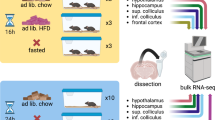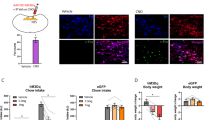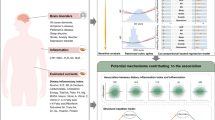Abstract
Highly palatable foods and dieting are major contributing factors for the development of compulsive eating in obesity and eating disorders. We previously demonstrated that intermittent access to palatable food results in corticotropin-releasing factor-1 (CRF1) receptor antagonist-reversible behaviors, which include excessive palatable food intake, hypophagia of regular chow, and anxiety-like behavior. However, the brain areas mediating these effects are still unknown. Male Wistar rats were either fed chow continuously for 7 days/week (Chow/Chow group), or fed chow intermittently 5 days/week, followed by a sucrose, palatable diet 2 days/week (Chow/Palatable group). Following chronic diet alternation, the effects of microinfusing the CRF1 receptor antagonist R121919 (0, 0.5, 1.5 μg/side) in the central nucleus of the amygdala (CeA), the basolateral nucleus of the amygdala (BlA), or the bed nucleus of the stria terminalis (BNST) were evaluated on excessive intake of the palatable diet, chow hypophagia, and anxiety-like behavior. Furthermore, CRF immunostaining was evaluated in the brain of diet cycled rats. Intra-CeA R121919 blocked both excessive palatable food intake and anxiety-like behavior in Chow/Palatable rats, without affecting chow hypophagia. Conversely, intra-BlA R121919 reduced the chow hypophagia in Chow/Palatable rats, without affecting excessive palatable food intake or anxiety-like behavior. Intra-BNST treatment had no effect. The treatments did not modify the behavior of Chow/Chow rats. Immunohistochemistry revealed an increased number of CRF-positive cells in CeA—but not in BlA or BNST—of Chow/Palatable rats, during both withdrawal and renewed access to the palatable diet, compared with controls. These results provide functional evidence that the CRF–CRF1 receptor system in CeA and BlA has a differential role in mediating maladaptive behaviors resulting from palatable diet cycling.
Similar content being viewed by others
Log in or create a free account to read this content
Gain free access to this article, as well as selected content from this journal and more on nature.com
or
References
Ahmed SH, Koob GF (2005). Transition to drug addiction: a negative reinforcement model based on an allostatic decrease in reward function. Psychopharmacology (Berl) 180: 473–490.
Avena NM, Bocarsly ME, Hoebel BG (2012). Animal models of sugar and fat bingeing: relationship to food addiction and increased body weight. Methods Mol Biol 829: 351–365.
Bakshi VP, Kalin NH (2000). Corticotropin-releasing hormone and animal models of anxiety: gene-environment interactions. Biol Psychiatry 48: 1175–1198.
Bale TL (2005). Sensitivity to stress: dysregulation of CRF pathways and disease development. Horm Behav 48: 1–10.
Blasio A, Iemolo A, Sabino V, Petrosino S, Steardo L, Rice KC (2013a). Rimonabant precipitates anxiety in rats withdrawn from palatable food: role of the central amygdala. Neuropsychopharmacology (doi:10.1038/npp.2013.153).
Blasio A, Steardo L, Sabino V, Cottone P (2013b). Opioid system in the medial prefrontal cortex mediates binge-like eating. Addict Biol (doi:10.1111/adb.12033).
Breese GR, Overstreet DH, Knapp DJ (2005). Conceptual framework for the etiology of alcoholism: a ‘kindling’/stress hypothesis. Psychopharmacology (Berl) 178: 367–380.
Bruijnzeel AW, Ford J, Rogers JA, Scheick S, Ji Y, Bishnoi M et al (2012). Blockade of CRF1 receptors in the central nucleus of the amygdala attenuates the dysphoria associated with nicotine withdrawal in rats. Pharmacol Biochem Behav 101: 62–68.
Chen C, Wilcoxen KM, Huang CQ, Xie YF, McCarthy JR, Webb TR et al (2004). Design of 2,5-dimethyl-3-(6-dimethyl-4-methylpyridin-3-yl)-7-dipropylaminopyrazolo[1,5-a]py rimidine (NBI 30775/R121919) and structure—activity relationships of a series of potent and orally active corticotropin-releasing factor receptor antagonists. J Med Chem 47: 4787–4798.
Corwin RL (2006). Bingeing rats: a model of intermittent excessive behavior? Appetite 46: 11–15.
Corwin RL, Grigson PS (2009). Symposium overview—food addiction: fact or fiction? J Nutr 139: 617–619.
Cottone P, Sabino V, Nagy TR, Coscina DV, Zorrilla EP (2007). Feeding microstructure in diet-induced obesity susceptible versus resistant rats: central effects of urocortin 2. J Physiol 583 (Pt 2): 487–504.
Cottone P, Sabino V, Roberto M, Bajo M, Pockros L, Frihauf JB et al (2009a). CRF system recruitment mediates dark side of compulsive eating. Proc Natl Acad Sci USA 106: 20016–20020.
Cottone P, Sabino V, Steardo L, Zorrilla EP (2008). Intermittent access to preferred food reduces the reinforcing efficacy of chow in rats. Am J Physiol Regul Integr Comp Physiol 295: R1066–R1076.
Cottone P, Sabino V, Steardo L, Zorrilla EP (2009b). Consummatory, anxiety-related and metabolic adaptations in female rats with alternating access to preferred food. Psychoneuroendocrinology 34: 38–49.
Cottone P, Wang X, Park JW, Valenza M, Blasio A, Kwak J et al (2012). Antagonism of sigma-1 receptors blocks compulsive-like eating. Neuropsychopharmacology 37: 2593–2604.
Dore R, Iemolo A, Smith KL, Wang X, Cottone P, Sabino V (2013). CRF mediates the anxiogenic and anti-rewarding, but not the anorectic effects of PACAP. Neuropsychopharmacology (doi:10.1038/npp.2013.113).
Funk CK, O'Dell LE, Crawford EF, Koob GF (2006). Corticotropin-releasing factor within the central nucleus of the amygdala mediates enhanced ethanol self-administration in withdrawn, ethanol-dependent rats. J Neurosci 26: 11324–11332.
George O, Ghozland S, Azar MR, Cottone P, Zorrilla EP, Parsons LH et al (2007). CRF-CRF1 system activation mediates withdrawal-induced increases in nicotine self-administration in nicotine-dependent rats. Proc Natl Acad Sci USA 104: 17198–17203.
Grigoriadis DE, Chen C, Wilcoxen K, Chen T, Lorang MT, Bozigion H et al (2000). In vitro characterization of R121919: a novel non-peptide corticotropin-releasing factor1 (CRF1) receptor antagonist for the potential treatment of depression and anxiety-related disorders. Society for Neuroscience Abstract 807: 4–9.
Hagan MM, Chandler PC, Wauford PK, Rybak RJ, Oswald KD (2003). The role of palatable food and hunger as trigger factors in an animal model of stress induced binge eating. Int J Eat Disord 34: 183–197.
Hatfield T, Han JS, Conley M, Gallagher M, Holland P (1996). Neurotoxic lesions of basolateral, but not central, amygdala interfere with Pavlovian second-order conditioning and reinforcer devaluation effects. J Neurosci 16: 5256–5265.
Heilig M, Egli M, Crabbe JC, Becker HC (2010). Acute withdrawal, protracted abstinence and negative affect in alcoholism: are they linked? Addict Biol 15: 169–184.
Heilig M, Koob GF (2007). A key role for corticotropin-releasing factor in alcohol dependence. Trends Neurosci 30: 399–406.
Heinrichs SC, Menzaghi F, Schulteis G, Koob GF, Stinus L (1995). Suppression of corticotropin-releasing factor in the amygdala attenuates aversive consequences of morphine withdrawal. Behav Pharmacol 6: 74–80.
Iemolo A, Valenza M, Tozier L, Knapp CM, Kornetsky C, Steardo L et al (2012). Withdrawal from chronic, intermittent access to a highly palatable food induces depressive-like behavior in compulsive eating rats. Behav Pharmacol 23: 593–602.
Koob GF (2008). A role for brain stress systems in addiction. Neuron 59: 11–34.
Koob GF (2009). Neurobiological substrates for the dark side of compulsivity in addiction. Neuropharmacology 56 (Suppl 1): 18–31.
Koob GF (2010). The role of CRF and CRF-related peptides in the dark side of addiction. Brain Res 1314: 3–14.
Koob GF, Heinrichs SC (1999). A role for corticotropin releasing factor and urocortin in behavioral responses to stressors. Brain Res 848: 141–152.
Koob GF, Le Moal M (2005). Plasticity of reward neurocircuitry and the 'dark side' of drug addiction. Nat Neurosci 8: 1442–1444.
Koob GF, Le Moal M (2008). Review. Neurobiological mechanisms for opponent motivational processes in addiction. Philos Trans R Soc Lond B Biol Sci 363: 3113–3123.
Koob GF, Volkow ND (2010). Neurocircuitry of addiction. Neuropsychopharmacology 35: 217–238.
Logrip ML, Koob GF, Zorrilla EP (2011). Role of corticotropin-releasing factor in drug addiction: potential for pharmacological intervention. CNS Drugs 25: 271–287.
Maj M, Turchan J, Smialowska M, Przewlocka B (2003). Morphine and cocaine influence on CRF biosynthesis in the rat central nucleus of amygdala. Neuropeptides 37: 105–110.
McNally GP, Akil H (2002). Role of corticotropin-releasing hormone in the amygdala and bed nucleus of the stria terminalis in the behavioral, pain modulatory, and endocrine consequences of opiate withdrawal. Neuroscience 112: 605–617.
Merlo Pich E, Lorang M, Yeganeh M, Rodriguez de Fonseca F, Raber J, Koob GF et al (1995). Increase of extracellular corticotropin-releasing factor-like immunoreactivity levels in the amygdala of awake rats during restraint stress and ethanol withdrawal as measured by microdialysis. J Neurosci 15: 5439–5447.
Murray E, Wise S, Rhodes S (2011). What can different brains do with reward? In Gottfried JA (eds). Neurobiology of Sensation and Reward, Chapter 4. CRC Press: Boca Raton, FL, USA.
Parylak SL, Koob GF, Zorrilla EP (2011). The dark side of food addiction. Physiol Behav 104: 149–156.
Paxinos G, Watson C (2007) The Rat Brain in Stereotaxic Coordinates 6th edn. Academic Press.
Pellegrino A (1979) A Stereotaxic Atlas of the Rat Brain. Plenum: New York.
Rodriguez de Fonseca F, Carrera MR, Navarro M, Koob GF, Weiss F (1997). Activation of corticotropin-releasing factor in the limbic system during cannabinoid withdrawal. Science 276: 2050–2054.
Sabino V, Cottone P, Steardo L, Schmidhammer H, Zorrilla EP (2007). 14-Methoxymetopon, a highly potent mu opioid agonist, biphasically affects ethanol intake in Sardinian alcohol-preferring rats. Psychopharmacology (Berl) 192: 537–546.
Salinas JA, Parent MB, McGaugh JL (1996). Ibotenic acid lesions of the amygdala basolateral complex or central nucleus differentially effect the response to reductions in reward. Brain Res 742: 283–293.
Shalev U, Erb S, Shaham Y (2010). Role of CRF and other neuropeptides in stress-induced reinstatement of drug seeking. Brain Res 1314: 15–28.
Vale W, Spiess J, Rivier C, Rivier J (1981). Characterization of a 41-residue ovine hypothalamic peptide that stimulates secretion of corticotropin and beta-endorphin. Science 213: 1394–1397.
Volkow ND, O'Brien CP (2007). Issues for DSM-V: should obesity be included as a brain disorder? Am J Psychiatry 164: 708–710.
Wellman LL, Gale K, Malkova L (2005). GABAA-mediated inhibition of basolateral amygdala blocks reward devaluation in macaques. J Neurosci 25: 4577–4586.
Yach D, Stuckler D, Brownell KD (2006). Epidemiologic and economic consequences of the global epidemics of obesity and diabetes. Nat Med 12: 62–66.
Acknowledgements
We thank Duncan Momaney, Aditi R Narayan, Jina Kwak for technical assistance, and Tamara Zeric for technical and editorial assistance. We also thank Elena F Crawford for helpful suggestions related to CRF immunohistochemistry. This publication was made possible by grant numbers DA023680, DA030425, MH091945, MH093650, and AA016731, from the National Institute on Drug Abuse (NIDA), the National Institute of Mental Health (NIMH), and the National Institute on Alcohol Abuse and Alcoholism (NIAAA), by the Peter Paul Career Development Professorship (PC) and by Boston University's Undergraduate Research Opportunities Program (UROP). This research was also supported by the NIH Intramural Research Programs of the National Institute on Drug Abuse, and the National Institute of Alcohol Abuse and Alcoholism, NIH, DHHS. Its contents are solely the responsibility of the authors and do not necessarily represent the official views of the National Institutes of Health.
Author information
Authors and Affiliations
Corresponding author
Additional information
Supplementary Information accompanies the paper on the Neuropsychopharmacology website
Supplementary information
Rights and permissions
About this article
Cite this article
Iemolo, A., Blasio, A., St Cyr, S. et al. CRF–CRF1 Receptor System in the Central and Basolateral Nuclei of the Amygdala Differentially Mediates Excessive Eating of Palatable Food. Neuropsychopharmacol 38, 2456–2466 (2013). https://doi.org/10.1038/npp.2013.147
Received:
Revised:
Accepted:
Published:
Issue date:
DOI: https://doi.org/10.1038/npp.2013.147
Keywords
This article is cited by
-
Current perspectives on brain circuits involved in food addiction-like behaviors
Journal of Neural Transmission (2024)
-
Pituitary adenylate cyclase-activating polypeptide (PACAP) modulates dependence-induced alcohol drinking and anxiety-like behavior in male rats
Neuropsychopharmacology (2021)
-
AMPK in the gut-liver-brain axis and its influence on OP rats in an HSHF intake and WTD rat model
Pflügers Archiv - European Journal of Physiology (2021)
-
Reward sensitivity deficits in a rat model of compulsive eating behavior
Neuropsychopharmacology (2020)
-
Oleoylethanolamide decreases frustration stress-induced binge-like eating in female rats: a novel potential treatment for binge eating disorder
Neuropsychopharmacology (2020)



